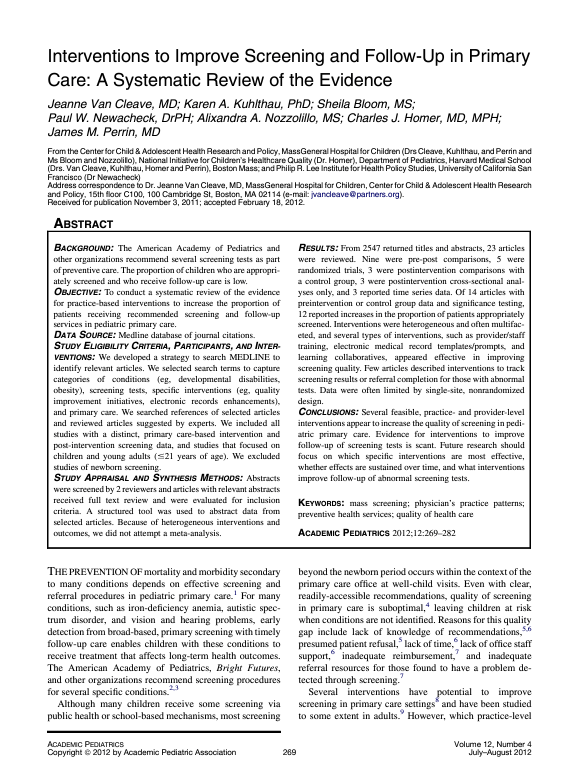Interventions to Improve Screening and Follow-Up in Primary Care: A Systematic Review of the Evidence
Academic Pediatrics
Abstract
Background: The American Academy of Pediatrics and other organizations recommend several screening tests as part of preventive care. The proportion of children who are appropriately screened and who receive follow-up care is low.
Objective: To conduct a systematic review of the evidence for practice-based interventions to increase the proportion of patients receiving recommended screening and follow-up services in pediatric primary care.
Data source: Medline database of journal citations.
Study eligibility criteria, participants, and interventions: We developed a strategy to search MEDLINE to identify relevant articles. We selected search terms to capture categories of conditions (eg, developmental disabilities, obesity), screening tests, specific interventions (eg, quality improvement initiatives, electronic records enhancements), and primary care. We searched references of selected articles and reviewed articles suggested by experts. We included all studies with a distinct, primary care-based intervention and post-intervention screening data, and studies that focused on children and young adults (≤21 years of age). We excluded studies of newborn screening.
Study appraisal and synthesis methods: Abstracts were screened by 2 reviewers and articles with relevant abstracts received full text review and were evaluated for inclusion criteria. A structured tool was used to abstract data from selected articles. Because of heterogeneous interventions and outcomes, we did not attempt a meta-analysis.
Results: From 2547 returned titles and abstracts, 23 articles were reviewed. Nine were pre-post comparisons, 5 were randomized trials, 3 were postintervention comparisons with a control group, 3 were postintervention cross-sectional analyses only, and 3 reported time series data. Of 14 articles with preintervention or control group data and significance testing, 12 reported increases in the proportion of patients appropriately screened. Interventions were heterogeneous and often multifaceted, and several types of interventions, such as provider/staff training, electronic medical record templates/prompts, and learning collaboratives, appeared effective in improving screening quality. Few articles described interventions to track screening results or referral completion for those with abnormal tests. Data were often limited by single-site, nonrandomized design.
Conclusions: Several feasible, practice- and provider-level interventions appear to increase the quality of screening in pediatric primary care. Evidence for interventions to improve follow-up of screening tests is scant. Future research should focus on which specific interventions are most effective, whether effects are sustained over time, and what interventions improve follow-up of abnormal screening tests.
